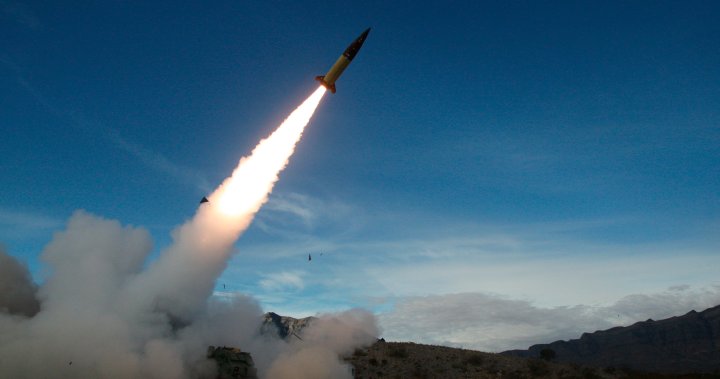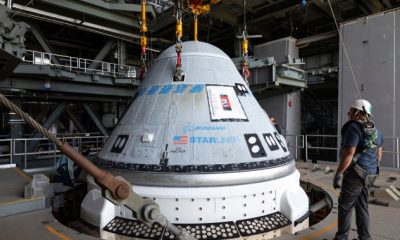General News
U.S. is sending Ukraine longer-range weapons with new aid. Why it matters – National

Ukraine has already begun using the most powerful long-range weapon systems delivered by the U.S. during the war with Russia to date, and will soon get its hands on more thanks to a requirement in the massive national security aid package signed into law Wednesday.
The U.S. Senate on Tuesday voted to approve the package passed by the House of Representatives last weekend that includes US$61 billion for Ukraine, finally unlocking a new round of military aid after months of delay.
The Ukraine aid bill includes a requirement for President Joe Biden to approve the transfer of long-range army tactical missile systems (ATACMS) to Ukraine “as soon as is practicable” after signing the aid into law.
Yet shortly after Biden signed the legislation, the White House revealed the president had authorized the delivery of ATACMS back in February, and U.S. officials confirmed Ukraine had already used them in a strike on a Russian airfield in Crimea last week.
“We’ve already sent some, we will send more now that we have additional authority and money,” National Security Advisor Jake Sullivan told reporters Wednesday. He declined to say how many of the missiles would be sent, or when.
“I believe they will make a difference (in the war with Russia), but as I’ve said before … there is no silver bullet in this conflict. One capability is not going to be the solution.”
The weapons, long sought by both Ukraine and Republican defence hawks, will further allow the Ukrainians to strike Russian targets — a tactic once seen as unnecessarily escalatory but that has become more common in recent months. The move to send them now reflects how those concerns have melted away in the face of Ukraine’s growing need, experts say.
“What you have seen over the last two years is … there’s been a kind of slow acceptance of, are we backing Ukraine simply to survive, or are we backing Ukraine to win?” said Colin Robertson, vice-president of the Canadian Global Affairs Institute and a former Canadian diplomat to the U.S.
Sullivan on Wednesday pointed to Russia’s use of long-range ballistic missiles provided by North Korea in its invasion as reason to give Ukraine a similar capability.

The Biden administration quickly announced a US$1 billion weapons package as the first batch of aid sent under the new bill once it was signed. Biden told reporters at the White House he expected the deliveries to be sent within “the next few hours” and include “air defence munitions, artillery, rocket systems and armoured vehicles.” He made no mention of long-range weapons.
Although it wasn’t immediately clear when more long-range missiles will be sent to the warfront, Biden and U.S. officials have stressed the importance of giving Ukraine everything it needs quickly to push back an encroaching Russia, which is currently outmanning and outfiring the Ukrainians.
Breaking news from Canada and around the world
sent to your email, as it happens.
“They’re under the gun right now, literally and figuratively,” White House national security spokesperson John Kirby told reporters aboard Air Force One on Tuesday.
Yet the Associated Press, citing U.S. officials, reported Wednesday before Sullivan’s comments that the earlier ATACMS deliveries were so secretive that lawmakers in Congress were unaware as they worked to include the provision for the weapons in the final aid bill.
Why are long-range weapons important?
During the first months of the war, the U.S. and western allies were hesitant to provide long-range weapons to Ukraine over fears that Russia would see it as escalation from NATO, with fears of expanding the war. There were also fears Ukraine itself could escalate the conflict by striking targets within Russia.
Those fears slowly began to thaw, with the U.S. first providing high mobility artillery rocket systems (HIMARS) — which Ukrainian soldiers have called a “game-changer” — followed by air defence systems that allowed Ukraine to shoot down and repel Russian missile strikes.
Both systems helped Ukraine push the Russians back to its occupied territories in eastern Donbas.
Soon, Ukraine was making the case for long-range missiles to strike back at and cripple the Russian fleet and military depots, including military and infrastructure targets in Russian-occupied Crimea.
While the Biden administration continued to fear escalation with Russia, European allies began to answer the call last year.
The United Kingdom began sending its Storm Shadow air-launched precision-guided cruise missiles in May 2023, followed by France sending its version of the missiles, known as SCALP. Both systems have a range of about 240 kilometres.

Kyiv has since credited Storm Shadow for successful strikes on Russian warships, submarines and military command hubs in its occupied territories, including Crimea. The U.K. announced Tuesday that it is sending more Storm Shadow missiles.
In October 2023, the U.S. quietly began supplying a shorter-range version of ATACMS to Ukraine, which American officials once again said was done to minimize escalation. But the U.S. did not publicly confirm the delivery for months. Instead, Zelenskyy announced at the time that the systems had been delivered and “executed very accurately” on the battlefield against Russia.
While some of the long-range weapons can go as far as about 300 kilometres, the ones sent to Ukraine last fall have a shorter range — U.S. officials privately told The Associated Press they travel up to 160 kilometres — and carry cluster munitions, which, when fired, open in the air, releasing hundreds of bomblets rather than a single warhead.
Unlike the Storm Shadow and SCALP cruise missiles, the long-range ATACMS fires ballistic missiles that don’t follow a straight flight path, making them difficult to impossible to take down with traditional air defence systems.
That makes the weapons a sought-after system despite the continued delivery of the European systems.
Republicans in Congress who support U.S. aid to Ukraine, including Leader Mitch McConnell, have said the Biden administration could have ensured an early Ukrainian victory by sending long-range ATACMS right away. They also reject concerns about escalation, arguing Ukraine has the right to fight back against increasingly devastating Russian missile and drone strikes.
“They are being attacked by Russia from Russian territory,” said Kurt Volker, a fellow at the Center for European Policy Analysis who served as a U.S. diplomat to NATO and Ukraine under the George W. Bush and Donald Trump administrations, respectively.
“To tell the Ukrainians that they should not hit back at those Russian forces that are hitting them, that’s a nonsensical position.”
Wednesday’s reports on the delivery of the longer-range ATACMS said Ukraine first used the missiles on April 17. Ukraine has also not publicly confirmed receiving the secretive deliveries.

Analysts say despite the growing calls from Ukraine supporters to supply the missiles, questions remain about whether Ukraine will use them in a way that raises the stakes of the war.
Kyiv has already embarked on a controversial campaign of drone attacks on oil and energy facilities inside mainland Russia, including a strike in the province of Tatarstan earlier this month that marked Ukraine’s deepest attack inside Russian territory since the war began. It has also continued its attacks on Russia’s fleet in the Black Sea.
“I guess the question is, what kind of safeguards are you going to have for Ukraine to not use (ATACMS) against targets in Russia proper, rather than territory that the Russians have taken,” said Richard Shimooka, a senior fellow at the Macdonald-Laurier Institute who focuses on defence policy.
Although Ukraine has so far demonstrated its accuracy in targeting Russian military targets, Shimooka continued, “What happens if they miss and hit a civilian target? Then what do you do?
“I think that’s what still has the Americans concerned.”
—with files from The Associated Press
Source
Disclaimer: No copyright infringement intended. All rights and credits reserved to respective owner(s).


























